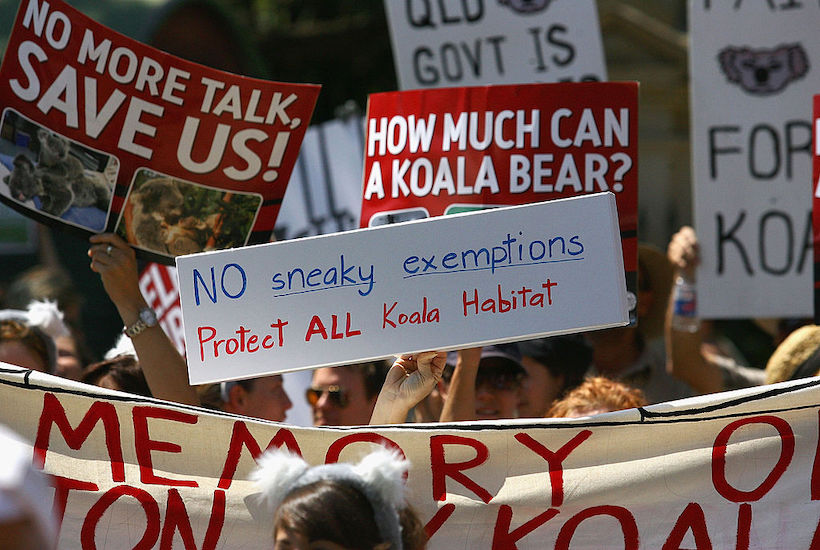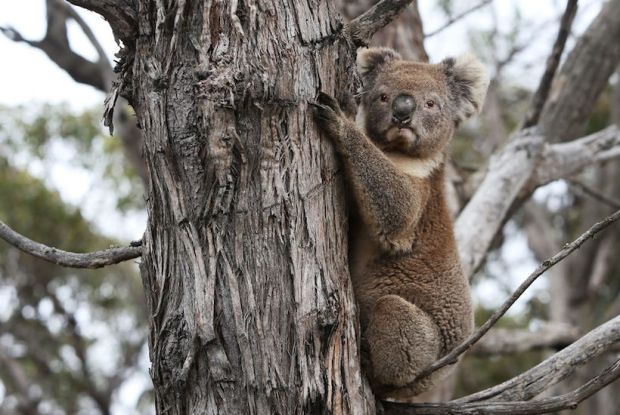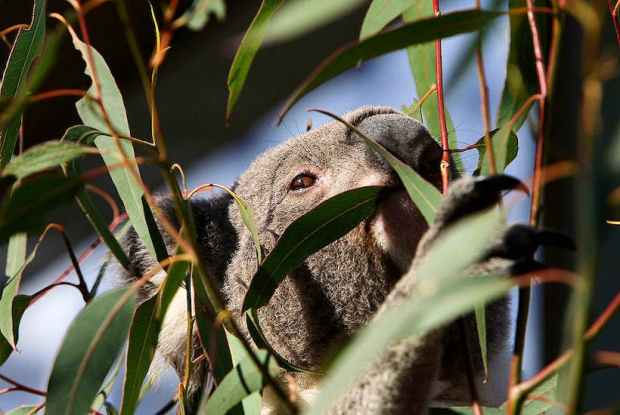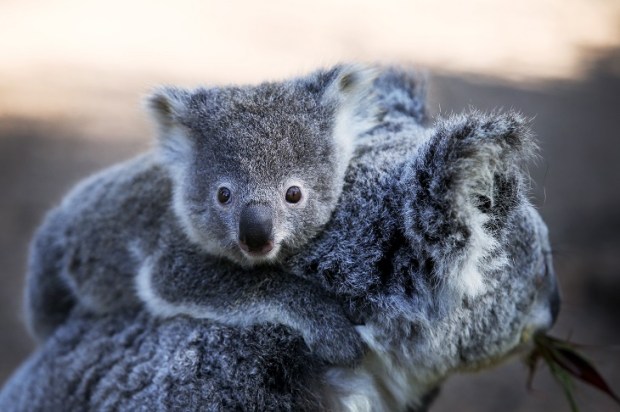Europeans learnt of koalas a decade after they arrived. John Price was shown some dung by a convict who’d lived with Aborigines. In 1802, Barallier’s guide, Gory, got him a koala’s feet, at a very high price. A year later, Aborigines caught one for the ‘new chums’. The Sydney Gazette reported it was “excessively nice” in its choice of leaves. Koalas are rare in healthy old forests where tender shoots are scarce.
In 1810 the koala was described as “a solitary animal rarely to be met with”. In 1821, Aborigines told Hume of koalas on a scrubby hill near the Shoalhaven’s source. Between 1817 and 1846, Oxley’s, Sturt’s and Mitchell’s parties explored throughout the koala’s range and saw none. They didn’t live in the grassy valleys coveted by Europeans. After half a century, Mitchell described dense young forests growing where Aboriginal burning had been disrupted. Govett found koalas “numerous” in the young stringybark forests of the Blue Mountains’ foothills. Aborigines made stringybark nooses on poles to catch them.
In 1840, Strzelecki became the only explorer to see koalas. They were in sapling scrubs grown up after Aborigines were decimated by smallpox. A 1789 epidemic swept the country from Torres to Bass Strait. After the Yowenjerre’s firesticks guttered, thick understoreys climbed out of deep dark gullies and covered the ranges now named after the Pole. When dry storms ignited megafires around 1820, eucalypts germinated in ashbeds, thick as hairs on a cat’s back. Saplings fed koala plagues which saved Strzelecki from starvation in the wilderness where there were no kangaroos or emus.
Gould surveyed koalas on the east coast. They were in “luxuriant brushes” from Illawarra to Moreton Bay, but they were “nowhere very abundant” and could “rarely be detected” even with Aborigines’ assistance. He predicted their extinction. Gilbert told him of a sighting at Moreton Bay in 1844. No others were reported there until they irrupted 50 years later. Then their numbers crashed in the Federation Drought.
Europeans ‘improved’ pastures, and paddock trees declined, constantly resprouting tender, nutritious shoots. Koalas spread out of the foothills and across the valleys. As paddock trees died, koalas continued to breed, but they suffered malnutrition and disease. Shooting koalas and selling their skins was a humane and economic response. However, it didn’t stop the irruptions. Only the Federation Drought brought them to an end.
Modern irruptions continue despite euthanasia, sterilisations and translocations. Thousands of translocated koalas died of starvation and disease during the Millennium Drought. So did many of those left behind in their overstocked, chronically declining habitats.
Grazing native pastures, like mild burning, can keep trees healthy and koalas scarce. From the 1970s, native forests at Moreton Bay were increasingly alienated for urbanisation. With removal of grazing and burning, koalas once again irrupted into unsustainably high densities. The Moreton Bay District became the Koala Coast. Predators, including feral dogs, native carpet snakes and chlamydia, irrupted as koalas multiplied. Young koalas, looking for food and a home, moved into new suburbs where they fell victims to dogs and motor vehicles.
The inevitable crashes during the Millennium Drought were blamed on past clearing (so-called extinction debt), disease, dog attacks and cars. But koalas also crashed in the Pilliga where there hadn’t been any clearing. Experts blamed climate change, even though the same cycle had occurred a century before. The 19th Century irruption occurred after pastoralists abandoned their runs, and eucalypts proliferated in former pine-box woodlands. It ended in droughts around World War I. Koalas irrupted again in the late 20th Century after foresters discontinued poisoning and ringbarking of eucalypts to promote cypress. Harvesting small defective ironbarks also created dense coppice. Soft young growth feeds irruptions of folivores. When it is shrivelled by drought, folivores crash.
After World War II, chainsaws and dozers enabled intensive harvesting which created dense young regrowth forests on NSW north coast. Koalas responded. By 1990, koalas were booming in vigorous regrowth, but rare in old growth reserves. Regrowth created by timber getting at Pine Creek was put into National Park to protect koalas. Meanwhile, mild burning was constrained to ‘protect’ the environment. Chronic eucalypt decline became widespread, and koalas irrupted through forests young and old.
Repeated mailouts by the New South Wales National Parks and Wildlife Service and the Office of Environment and Heritage up to 2006, found that koalas were increasing at Coffs Harbour. This didn’t help to attract increased research funding or create more Parks. Another mail-out revealed more sightings. In 2016, OEH reported: “While the raw data show an increase in the number of koalas … they do not account for the forgetfulness of people”. They “downsampled” the data and “adjusted” them for “forgetfulness”. An increase in sightings became “a small, yet statistically significant, decline” in koalas.
This was handy for the Chief Scientist’s Independent Review into the Decline of Koala Populations in Key Areas of NSW, because Coffs Harbour was one of the Key Areas. A “supporting paper” – NSW koala population case studies – was published on the Chief Scientist’s website. Neither OEH, nor the Chief Scientist took ownership. It’s cited as a Document prepared by Martin Predavec [of OEH]. Perhaps this is a signal of independence.
Scientific research shows that koalas are five times more abundant at Coffs Harbour than previously reported. Unsustainably dense populations have irrupted through the declining forests. Densities are even higher near Bega, where OEH used mail–outs and models to ‘show’ they are extinct, except for a handful in a ‘climate refuge’. They declared a new koala park containing 40 year old regrowth from clearfelling and wildfire, which hasn’t had any mild burning. OEH has admitted that koalas are increasing, but hasn’t noticed that the trees are declining.
I told NSW Koala Inquiry:
Denial of history leads us to set up reserves of dying trees and scrub for unsustainable populations … they face lingering death in droughts or incineration in megafires. You have … photos of a koala … crossing the highway south of Eden … where Dr Lunney [OEH] says they are extinct.
There are … too many koalas because of the … chronically declining forest. That is … why we are having uncontrollable wildfires … look at the ground … all litter and dead wood … continuous with scrub in the middle and … with the thinning canopy on the top. You get a fire in that, it is uncontrollable … you get firestorms and ember showers … tens of kilometres in front of the fire…
Soon after, this bush was incinerated by the megafire that devastated Mallacoota. I provided before and after photos to the Inquiry. They didn’t publish them, nor did they truthfully report my evidence:
The committee heard one counterargument … Jurskis … opposed the idea that koala populations were in decline … His evidence was that grazing, burning and logging keeps forests healthy and thus, increases koala populations.
Testimony from preferred witnesses such as Dr. Kellie Leigh of Science for Wildlife supported my argument that koalas irrupt in unmanaged reserves:
We are finding … large, growing populations … particularly in Wollemi National Park … Everywhere we look we find a lot of koalas … They appear to be breeding well … a young and expanding population, particularly up in Kanangra.
Government inquiries seem to hear only what they want to hear. Two Senate inquiries reported: “the koala population prior to European settlement was in the order of up to 10 million koalas”. “One significant example of the decline of a previously abundant species is the koala”. AKF told them “Up until the 1930s millions of koalas were shot for the fur trade. There may have been up to 10,000,000 koalas”. And “Very little is known about the history and distribution of the koala prior to the fur trade”. One Inquiry cited a book referring to Gould’s historical reports. Incredibly the author, Bill Phillips, had written: “there seems little doubt that koalas were present in large numbers”.
The WWF claims that “Just 230 years ago, many millions of koalas roamed the great forests and bushland of eastern Australia”. NPA promotes a Great Koala National Park for NSW, stating that “We know from historical accounts that at the time of European settlement koalas were abundant on the east coast … numbers plummeted … between 1990 and 2010”. These numbers were fabricated by academics who actually boasted of doing so: “It was not necessary to achieve high levels of certainty … A quantitative, scientific method for deriving estimates of koala populations and trends was possible, in the absence of empirical data on abundances”.
I’d previously thought that building careers and empires on falsehoods and concocted crises was stupid – that the truth will out. Silly me! No one’s asking whence came all the thousands of supposedly near–extinct koalas that were incinerated during Black Summer.
Now New South Wales Liberals Environment Minister Matt Kean has achieved a stunning PR coup by promising to double koala populations in the next 30 years. While consistently denying history, it seems he either knew full well that koalas are an irruptive species, or his bureaucrats cunningly worded him up after the fires.
Vic Jurkis is a former NSW Forestry Commission professional forester, Officer in Charge of the Forestry Commission’s Regional Research Centre at Eden, the Forestry Commission’s Regional Planning Manager at Eden and Silviculturist for the Commission’s Native Forest Division, responsible for forest management across the State. In 2004 he was awarded a Fellowship by the Joseph William Gottstein Memorial Trust, to investigate eucalypt decline across Australia. He has published two books, Firestick Ecology, and The Great Koala Scam: Green propaganda, junk science, government waste and cruelty to animals, both available from Connor Court.
Got something to add? Join the discussion and comment below.
Got something to add? Join the discussion and comment below.
Get 10 issues for just $10
Subscribe to The Spectator Australia today for the next 10 magazine issues, plus full online access, for just $10.


























Comments
Don't miss out
Join the conversation with other Spectator Australia readers. Subscribe to leave a comment.
SUBSCRIBEAlready a subscriber? Log in